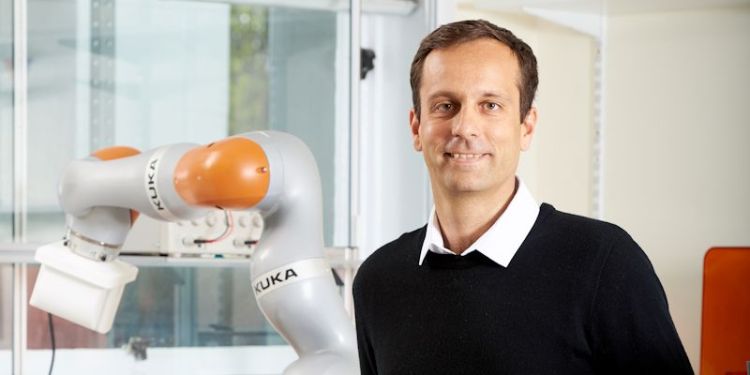Robotic technology for transforming colonoscopy and surgery

With an aging population increasing the risk of bowel cancer and inflammatory bowel disease on the rise, more than 1 million patients in the UK and 15 million in the US are scheduled for a colonoscopy each year. Professor of Robotics and autonomous systems, Pietro Valdastri and his team at the STORM lab, are pioneering a new design of endoscope that will enable faster, painless, low cost investigations.
Traditional methods of endoscopy can cause discomfort and pain because they are introduced to the colon by pushing the device through the body. The human gut tissue pain receptors are particularly sensitive to stretching, which is an unavoidable effect with the traditional design of endoscope. In the US deep anaesthesia is used for all colonoscopies, which increases cost and risk. In the UK where conscious sedation is preferred, many colonoscopies are not completed because of discomfort to patients, increasing the risk of undiagnosed cancers.
The new technology uses a magnetic capsule, with built-in imaging capability, which is propelled forwards through the body by an external magnetic robot arm. Pietro explains “what we are doing is front wheel drive and has a very flexible body. We have sensors inside which tell us where the capsule is, which is crucial to positon the external magnet in the proper way to move it forward.”
The operator uses the camera in the capsule to drive it forward or backwards with a joystick, like driving a car. The joystick makes it easy to learn how to operate the system as it will be familiar to users because it is similar to a gaming console controller. There is currently a long training time to use the complicated controls of traditional endoscopes and a shortage of skilled operators in the UK, which the ease of use of the new technology could alleviate.
“We can also levitate the capsule so it is in the middle of the column and doesn’t even touch the tissue. The camera allows the operator to look backwards as well as forwards, impossible with a conventional scope, so that polyps and cancer which is hidden behind folds in the gastric column can be seen” explains Professor Valdastri.
The camera allows the operator to look backwards as well as forwards... so that polyps and cancer which is hidden behind folds in the gastric column can be seen.
The system can also be driven autonomously at the touch of a button, with the operator needed only to feed the tube. This will speed up the procedure to around two minutes to reach the end of the colon, enabling the gastroenterologist to use the flexible head of the device to look for cancer as the endoscope is withdrawn. The hope is that faster procedures will mean many more patients can be seen, easing the current waiting times and also that most procedures will be completed.
...faster procedures will mean many more patients can be seen, easing the current waiting times and also that most procedures will be completed.
The technology, supported by funding from UK research council EPSRC, Cancer Research UK, and by the US National Institutes of Health, has passed pre-clinical trials. The team plan to begin human trials in 2020 with a group of patients in Leeds, to test pain response and ease of use, followed by multi centre international trials with academic partners at Vanderbilt University, the University of Turin and the Chinese University of Hong Kong.
Pietro Valdastri’s vision is that eventually a single gastroenterology specialist could oversee multiple simultaneous investigations, assisted by nursing staff and AI systems to detect possible cancer polyps, with the doctor taking biopsies through the endoscopic tube when a potential cancer is detected.
The technology should also reduce the cost of endoscopes because parts are cheap and disposable and so don’t necessarily need a hospital setting for sterilisation of endoscopes.
Magnetic tentacles
Professor Valdastri’s team are also working on a system of miniature magnetic tentacles that could be used to reach many areas of the body that it is currently difficult for surgeons to access. Potential uses could be in lung tumour biopsies or cardiovascular imaging, where currently the risk of tissue perforations is very high at 17%. The European Research Council has just awarded the team a prestigious Consolidator Grant, worth 5 years funding to develop the technology further.
The tiny tentacles are less than 1mm diameter and have a very soft, highly flexible body made up of a series of tiny magnetic particles, embedded along its length that can be controlled by an external robotic magnetic arm. “We can control foot shape, or stiffen the body and control the tip”, explains Professor Valdastri, “when it is put near an external magnet it changes shape. We are still working on how to drive the device from the outside and trialling different options”.
The team is also collaborating with Glasgow University on an EPSRC funded project to explore the use of the technology in bone surgery. The research is still at the developmental stage and is still several years away from clinical trials in areas of medicine which could benefit.
Contact us
If you would like to discuss this area of research in more detail, please contact Professor Pietro Valdastri.

